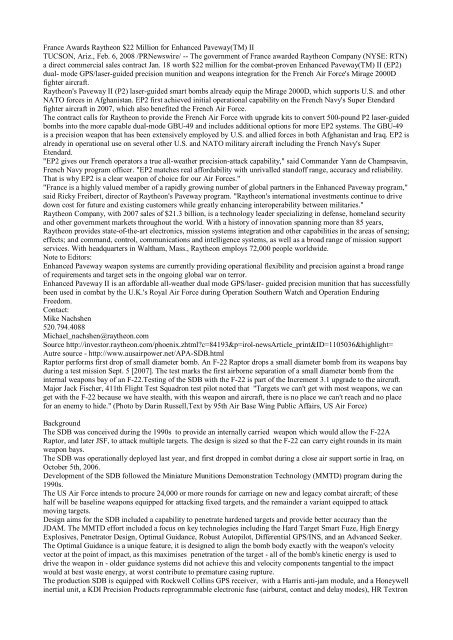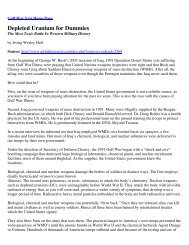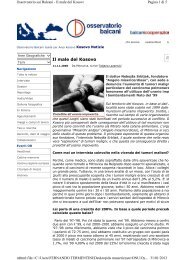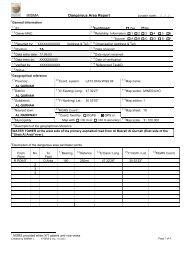France Awards Raytheon $22 Million for Enhanced Paveway(TM) II ...
France Awards Raytheon $22 Million for Enhanced Paveway(TM) II ...
France Awards Raytheon $22 Million for Enhanced Paveway(TM) II ...
You also want an ePaper? Increase the reach of your titles
YUMPU automatically turns print PDFs into web optimized ePapers that Google loves.
<strong>France</strong> <strong>Awards</strong> <strong>Raytheon</strong> <strong>$22</strong> <strong>Million</strong> <strong>for</strong> <strong>Enhanced</strong> <strong>Paveway</strong>(<strong>TM</strong>) <strong>II</strong><br />
TUCSON, Ariz., Feb. 6, 2008 /PRNewswire/ -- The government of <strong>France</strong> awarded <strong>Raytheon</strong> Company (NYSE: RTN)<br />
a direct commercial sales contract Jan. 18 worth <strong>$22</strong> million <strong>for</strong> the combat-proven <strong>Enhanced</strong> <strong>Paveway</strong>(<strong>TM</strong>) <strong>II</strong> (EP2)<br />
dual- mode GPS/laser-guided precision munition and weapons integration <strong>for</strong> the French Air Force's Mirage 2000D<br />
fighter aircraft.<br />
<strong>Raytheon</strong>'s <strong>Paveway</strong> <strong>II</strong> (P2) laser-guided smart bombs already equip the Mirage 2000D, which supports U.S. and other<br />
NATO <strong>for</strong>ces in Afghanistan. EP2 first achieved initial operational capability on the French Navy's Super Etendard<br />
fighter aircraft in 2007, which also benefited the French Air Force.<br />
The contract calls <strong>for</strong> <strong>Raytheon</strong> to provide the French Air Force with upgrade kits to convert 500-pound P2 laser-guided<br />
bombs into the more capable dual-mode GBU-49 and includes additional options <strong>for</strong> more EP2 systems. The GBU-49<br />
is a precision weapon that has been extensively employed by U.S. and allied <strong>for</strong>ces in both Afghanistan and Iraq. EP2 is<br />
already in operational use on several other U.S. and NATO military aircraft including the French Navy's Super<br />
Etendard.<br />
"EP2 gives our French operators a true all-weather precision-attack capability," said Commander Yann de Champsavin,<br />
French Navy program officer. "EP2 matches real af<strong>for</strong>dability with unrivalled standoff range, accuracy and reliability.<br />
That is why EP2 is a clear weapon of choice <strong>for</strong> our Air Forces."<br />
"<strong>France</strong> is a highly valued member of a rapidly growing number of global partners in the <strong>Enhanced</strong> <strong>Paveway</strong> program,"<br />
said Ricky Freibert, director of <strong>Raytheon</strong>'s <strong>Paveway</strong> program. "<strong>Raytheon</strong>'s international investments continue to drive<br />
down cost <strong>for</strong> future and existing customers while greatly enhancing interoperability between militaries."<br />
<strong>Raytheon</strong> Company, with 2007 sales of $21.3 billion, is a technology leader specializing in defense, homeland security<br />
and other government markets throughout the world. With a history of innovation spanning more than 85 years,<br />
<strong>Raytheon</strong> provides state-of-the-art electronics, mission systems integration and other capabilities in the areas of sensing;<br />
effects; and command, control, communications and intelligence systems, as well as a broad range of mission support<br />
services. With headquarters in Waltham, Mass., <strong>Raytheon</strong> employs 72,000 people worldwide.<br />
Note to Editors:<br />
<strong>Enhanced</strong> <strong>Paveway</strong> weapon systems are currently providing operational flexibility and precision against a broad range<br />
of requirements and target sets in the ongoing global war on terror.<br />
<strong>Enhanced</strong> <strong>Paveway</strong> <strong>II</strong> is an af<strong>for</strong>dable all-weather dual mode GPS/laser- guided precision munition that has successfully<br />
been used in combat by the U.K.'s Royal Air Force during Operation Southern Watch and Operation Enduring<br />
Freedom.<br />
Contact:<br />
Mike Nachshen<br />
520.794.4088<br />
Michael_nachshen@raytheon.com<br />
Source http://investor.raytheon.com/phoenix.zhtml?c=84193&p=irol-newsArticle_print&ID=1105036&highlight=<br />
Autre source - http://www.ausairpower.net/APA-SDB.html<br />
Raptor per<strong>for</strong>ms first drop of small diameter bomb. An F-22 Raptor drops a small diameter bomb from its weapons bay<br />
during a test mission Sept. 5 [2007]. The test marks the first airborne separation of a small diameter bomb from the<br />
internal weapons bay of an F-22.Testing of the SDB with the F-22 is part of the Increment 3.1 upgrade to the aircraft.<br />
Major Jack Fischer, 411th Flight Test Squadron test pilot noted that "Targets we can't get with most weapons, we can<br />
get with the F-22 because we have stealth, with this weapon and aircraft, there is no place we can't reach and no place<br />
<strong>for</strong> an enemy to hide." (Photo by Darin Russell,Text by 95th Air Base Wing Public Affairs, US Air Force)<br />
Background<br />
The SDB was conceived during the 1990s to provide an internally carried weapon which would allow the F-22A<br />
Raptor, and later JSF, to attack multiple targets. The design is sized so that the F-22 can carry eight rounds in its main<br />
weapon bays.<br />
The SDB was operationally deployed last year, and first dropped in combat during a close air support sortie in Iraq, on<br />
October 5th, 2006.<br />
Development of the SDB followed the Miniature Munitions Demonstration Technology (MMTD) program during the<br />
1990s.<br />
The US Air Force intends to procure 24,000 or more rounds <strong>for</strong> carriage on new and legacy combat aircraft; of these<br />
half will be baseline weapons equipped <strong>for</strong> attacking fixed targets, and the remainder a variant equipped to attack<br />
moving targets.<br />
Design aims <strong>for</strong> the SDB included a capability to penetrate hardened targets and provide better accuracy than the<br />
JDAM. The MMTD ef<strong>for</strong>t included a focus on key technologies including the Hard Target Smart Fuze, High Energy<br />
Explosives, Penetrator Design, Optimal Guidance, Robust Autopilot, Differential GPS/INS, and an Advanced Seeker.<br />
The Optimal Guidance is a unique feature, it is designed to align the bomb body exactly with the weapon's velocity<br />
vector at the point of impact, as this maximises penetration of the target - all of the bomb's kinetic energy is used to<br />
drive the weapon in - older guidance systems did not achieve this and velocity components tangential to the impact<br />
would at best waste energy, at worst contribute to premature casing rupture.<br />
The production SDB is equipped with Rockwell Collins GPS receiver, with a Harris anti-jam module, and a Honeywell<br />
inertial unit, a KDI Precision Products reprogrammable electronic fuse (airburst, contact and delay modes), HR Textron
tailfin actuators, MBDA diamondback foldout wings, with a TAM Garland 50 lb <strong>for</strong>ged casing warhead. A Mil-Std-<br />
1760 interface is used. The launcher is a Sargent Fletcher pneumatic ejector system in the Boeing BRU-61/A bomb<br />
rack.<br />
SRI are providing differential GPS ground stations, required to enhance SDB accuracy over JDAM and other<br />
conventional munitions.<br />
The glide wings provide a quoted delivery range of around 60 nautical miles <strong>for</strong> a high altitude release. The weapon<br />
per<strong>for</strong>ms a 180 degree roll post launch as the stowed configuration has the folded wings beneath the weapon.<br />
The cited blast radius is 26 ft (cf 82 ft with 2,000-lb JDAM). Boeing claim the ability to penetrate more than 5 ft of steel<br />
rein<strong>for</strong>ced concrete making the SDB competitive against the BLU-109/B <strong>for</strong> many targets.<br />
The SDB will be most effective in the urban and broader close air support, battlefield interdiction, Destruction of<br />
Enemy Air Defences (DEAD) lethal suppression and counter-air strike airfield attack roles. Against soft skinned<br />
vehicles and structures, armour, point emplacements, runways, aircraft shelters and SAM/SPAAG systems this weapon<br />
will be highly lethal.<br />
Where the SDB will be less than effective is against deep / hardened bunkers, large infrastructure targets, large<br />
buildings, industrial plant, bridges, large trench systems, vehicle parks, infantry on the move and other area or large<br />
point targets. These remain the domain of larger specialised bunker busting weapons, or large explosive bombs such as<br />
the Mk.83/BLU-110 (1,000 lb), Mk.84/BLU-117/BLU-119 (2,000 lb), BLU-109/116/118 (2,000 lb), BLU-113/122<br />
(5,000 lb).<br />
The GBU-40/B / GBU-42/B Small Diameter Bomb <strong>II</strong> is in development, it will be equipped with a multimode terminal<br />
seeker and two way datalink, and is expected to enter production at the end of the decade.











